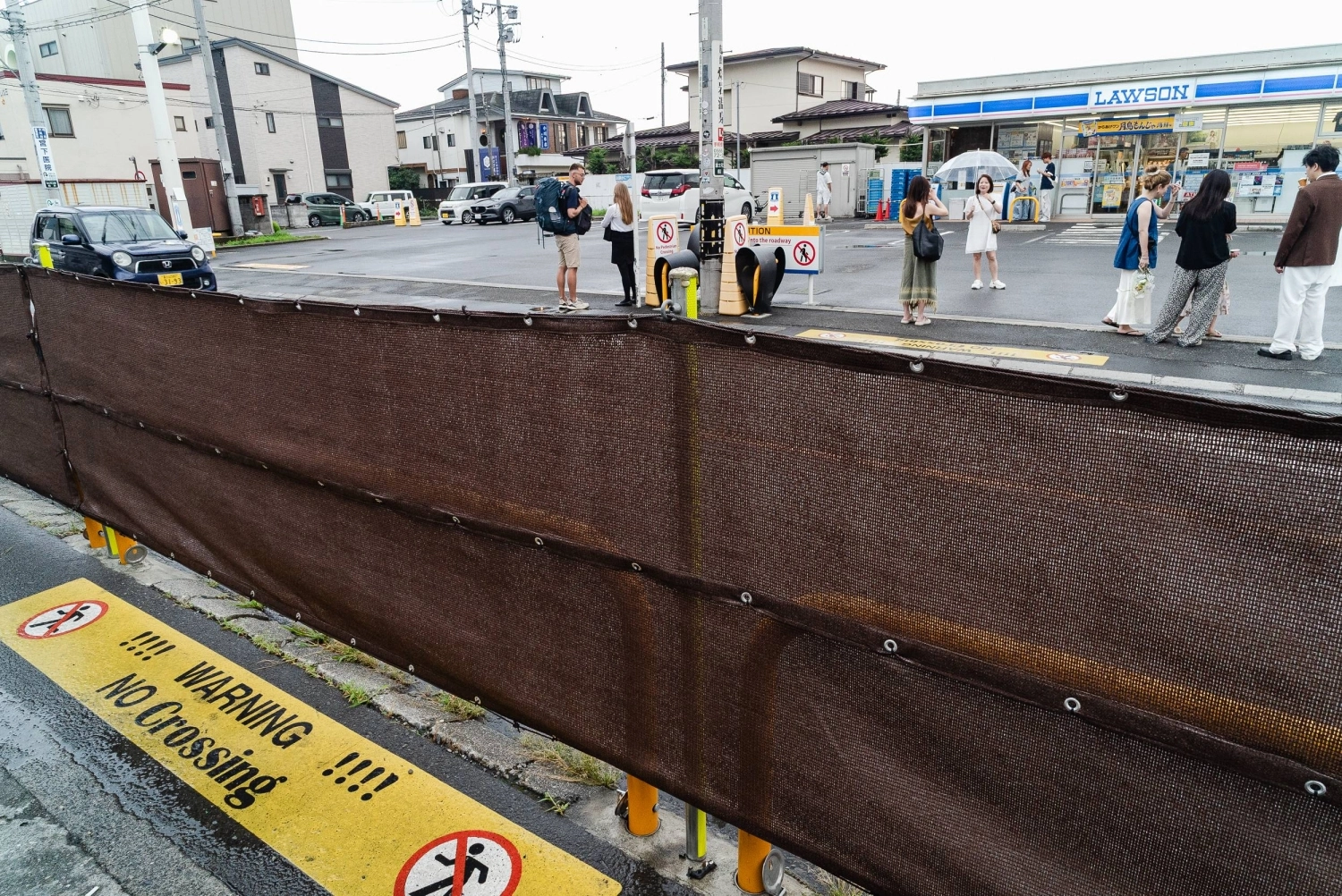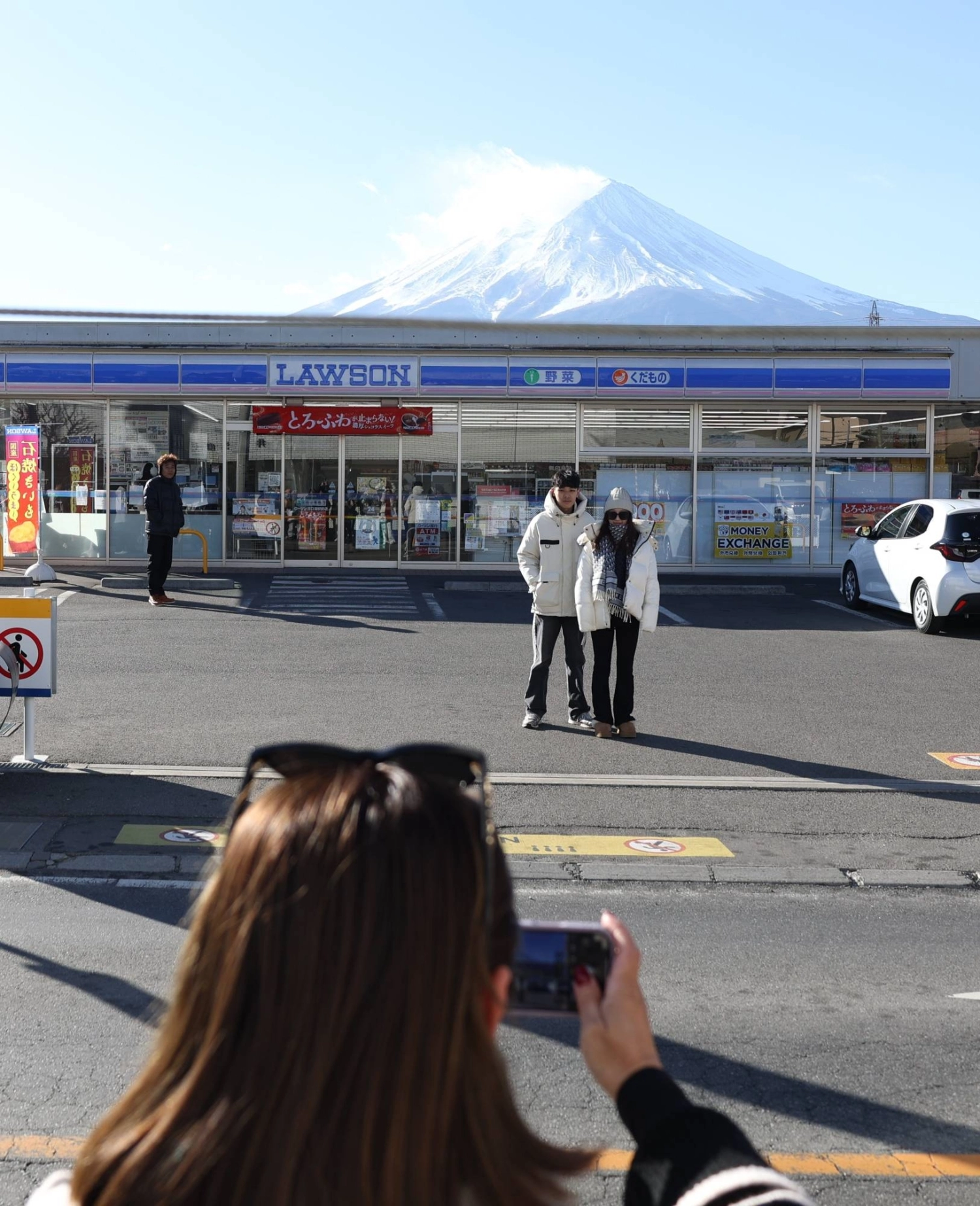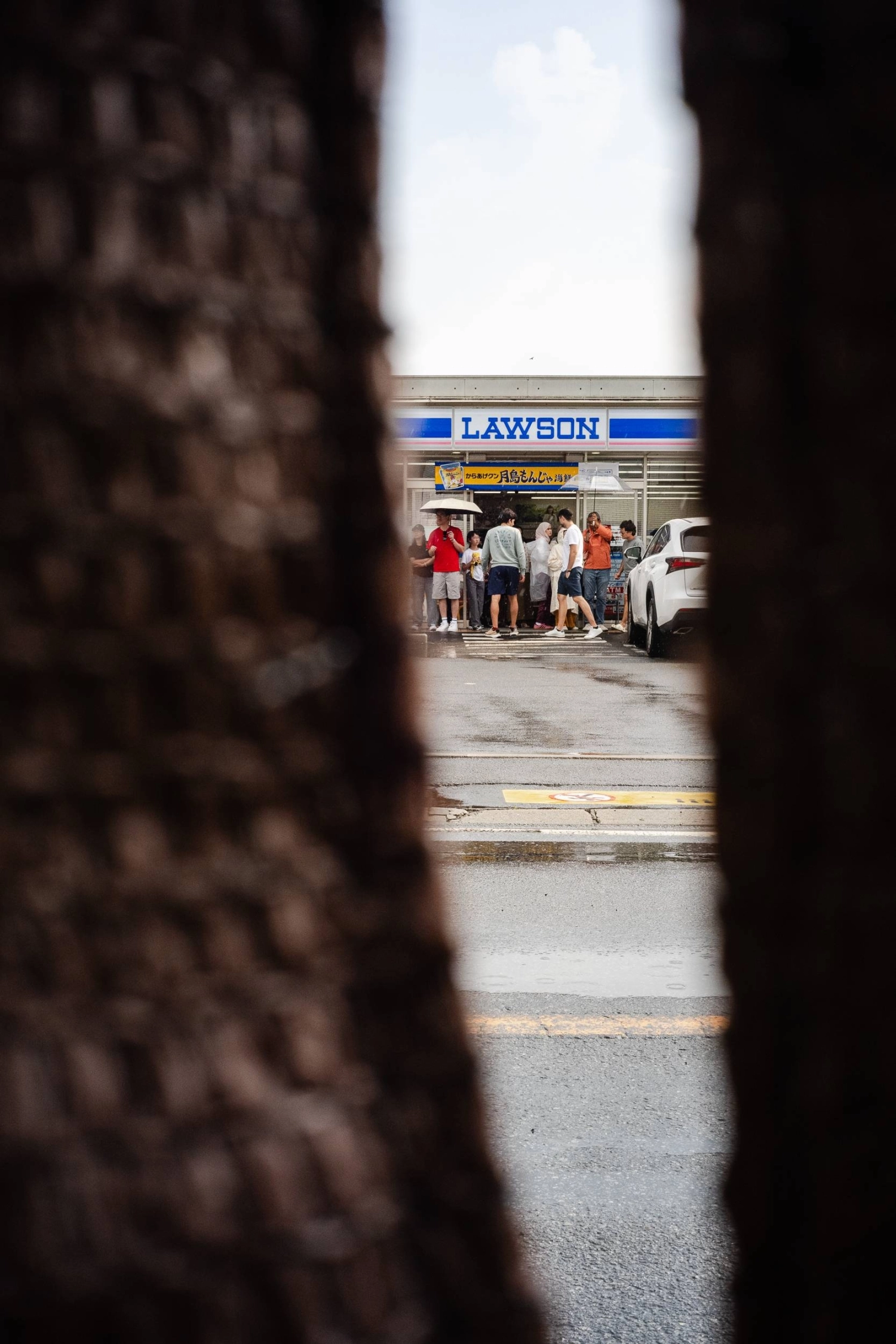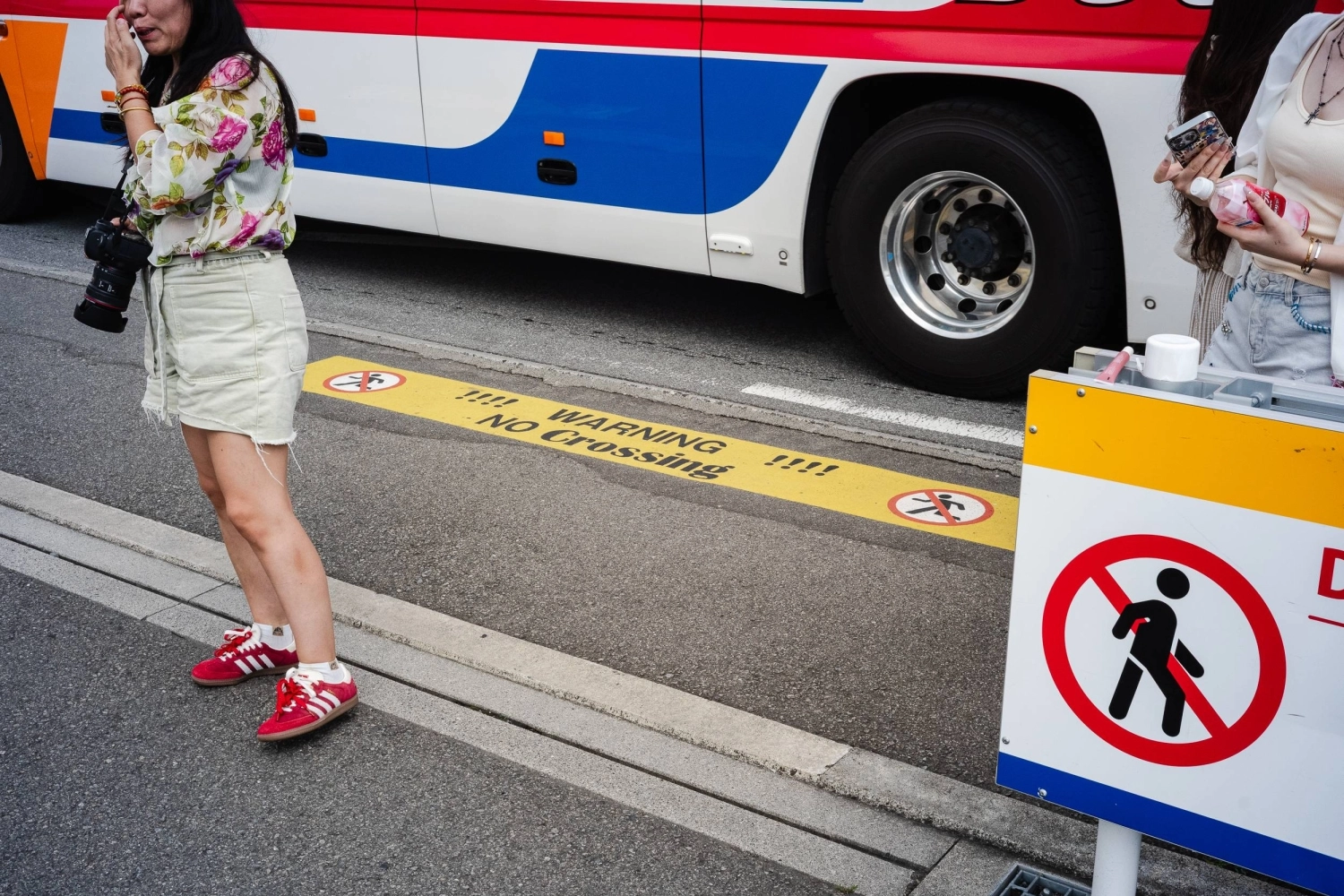Fujikawaguchiko, Yamanashi Pref. –
On a cloudy morning in August, a couple in wedding attire posed outside a Lawson outlet, in hopes of replicating a photo — taken at the same spot with both the convenience store and Mount Fuji in the background — that went viral last year.
The scene served as an oddly poignant reminder that in today’s age of social media, the journey often follows the photo, not the other way around.
The couple is among a flood of foreign tourists attracted to Lawson’s branch at Kawaguchiko Station in the town of Fujikawaguchiko, Yamanashi Prefecture — one of Japan’s unlikeliest tourist landmarks. But the viral view has brought chaos along with visitors.
The story of the Fujikawaguchiko Lawson is an example of what Japan is facing overall — the challenges of overtourism triggered by social media, and the local government’s struggle to balance welcoming visitors and preserving the quality of life for local residents.
Over the past year, the town has cycled through a series of increasingly desperate measures to rein in the crowds.
In April 2024, the town stationed security guards outside the Lawson to stop people from spilling into the street. A month later, a 2.5-meter-high, 20-meter-wide black curtain was erected to block the view of Mount Fuji. Tourists poked holes in it, eager to replicate the viral shot no matter what, so the town replaced it with a brown version that quickly met the same fate.
The curtain was ultimately taken down.
This month, a shorter curtain was installed. At 1.5 meters high, it is a compromise that allows tourists to take photos of the Lawson against the mountain but prevents people from slipping through roadside barriers.

At 1.5 meters high, a dark curtain is a compromise that allows tourists to take photos of Lawson and Mount Fuji but prevents people from slipping through roadside barriers.
| Johan Brooks
“The purpose of the curtain installed this time is completely different from before,” town tourism official Miruto Nakamura said in a written response to The Japan Times. “The current installation is not intended as a blindfold, but rather to prevent people from crossing through gaps in the pedestrian barrier.”
The rise in visitor numbers has also resulted in littering and other unwanted behavior from some tourists.
“Rules vary across regions and locations. If you are here for sightseeing, please be mindful of our manners and morals,” he said.
But the scene was still chaotic on a recent Monday, with a security guard standing by the curtain, barking instructions at pedestrians who ignored traffic rules or stood in the way of incoming traffic.
One tourist driving past shouted in English out of their car window, “I can see it, I can see it! That’s it!”
Canadian couple Natalia Podstreleny and Adam MacKillop, self-described “konbini fans” who once lived in Tokyo, turned up after coming across the photogenic Lawson on Instagram while waiting for their children to finish a Mount Fuji climb. They weren’t put off by the curtain.
“I don’t mind if they think it’s in the best interest,” Podstreleny said. “It’s not to put people off — it’s to keep people safe.”

Tourists take photos of the Fujikawaguchiko Lawson and Mount Fuji in January.
| JIJI
Despite the chaos, the flood of tourists has been good for local businesses.
“I’m grateful that people are coming all the way here. It’s a once-in-a-lifetime experience for them to see Fuji,” said Michie Motomochi, 42, a local resident who owns a Japanese sweets shop and cafe.
She dismissed the curtain as unnecessary. “Tourists are a great thing for this town. Get rid of the curtain, make it look nice!”
However, Motomochi said that she understands the perspective of locals who want to keep the town peaceful and quiet.
Wakana Watanabe, 44, another resident who runs a store that sells yukata (summer kimono) near the Lawson store, agrees.
In terms of toilets and garbage disposal, the town struggles to accommodate large tourist numbers. And while the number of visitors dropped when the full-size curtain was put up, which affected business, there was also a separate problem of misbehaving tourists.
“It’s good that the town is lively, but there’s a limit,” Watanabe said.

The Lawson outlet is seen through a gap in the barrier. On sunny days, Mount Fuji is visible in the background.
| Johan Brooks
Masako Carrero Hernandez, who runs a food truck with her husband, Valodia, in the town, is concerned about the safety of tourists on the street facing the Lawson.
“It’s so dangerous, people just jump into the road,” she said. To them, the curtain may look pointless, but safety concerns are real.
A former Fujikawaguchiko town official who was in charge of the tourism department that handled the debacle until April recalls being criticized by local business owners when the town installed the curtain last year.
“People would say, ‘Why are you driving people away in a town that relies on tourism?’” said Masakazu Togawa, 58, who is now the owner of an ice cream shop.
He believes that installing a shorter curtain this time around is a good compromise. “Tourists can still get good photos, and they won’t be disappointed,” he said. “We want them to enjoy themselves and make good memories.”
However, Togawa also stressed that Japan must do more than simply hang up a piece of fabric as a quick-fix solution to its tourism problem.
“Overtourism is an issue the whole country faces. We need to improve infrastructure and roads. Japan has to be forward-thinking in how it approaches this influx of visitors,” he said.

Signs warn tourists against crossing the road in front of the Lawson outlet in Kawaguchiko.
| Johan Brooks
Indeed, Fujikawaguchiko is not the only area struggling with overtourism. In Kyoto’s Gion district, residents have protested as crowds ambush maiko (young female entertainers) for photos on their way to appointments, and local infrastructure is struggling to keep up with the hordes of inbound tourists.
In the seaside city of Kamakura, Kanagawa Prefecture, the region’s iconic Enoden train line featured in a popular Japanese anime is often crammed with visitors, rendering it congested and unusable for local residents.
Fujikawaguchiko is a microcosm of what’s happening in a growing number of cities and towns across the country. And there is a limit to what municipalities can do on their own.
“The convenience store has become a symbol of overtourism in Japan,” said Meiji Takahashi, 57, who works at a tourist base that hosts a cafe and transport rental hub in Fujikawaguchiko.
“There needs to be cooperation between government and residents, but that takes time,” Takahashi said. “Japan needs to open itself widely for economic reasons — we live in a global society after all — but at the same time, we have to be honest about the barriers to welcoming tourists.”


AloJapan.com